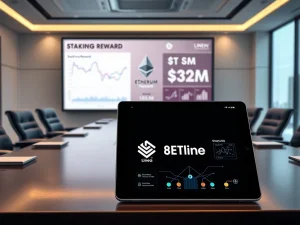Solana Network Unleashes Revolutionary 20% Block Size Upgrade for Unprecedented Scalability

The crypto world is buzzing with news from the Solana ecosystem! In a significant move set to redefine its performance benchmarks, the Solana network has officially activated a groundbreaking 20% block size increase. This isn’t just a technical tweak; it’s a strategic leap aimed at propelling Solana into a new era of efficiency and adoption. For anyone tracking the pulse of high-performance blockchains, this upgrade signals a powerful commitment to tackling the persistent challenges of speed and capacity in the decentralized space.
Unpacking Solana’s Pivotal Block Size Upgrade
The recent activation of a 20% block size increase on the Solana network marks a critical milestone in its ongoing quest for unparalleled efficiency. This isn’t merely an arbitrary adjustment; it’s a meticulously planned enhancement based on the SIMD-0256 proposal. Previously capped at 50 million compute units (CUs), each Solana block can now accommodate a staggering 60 million CUs. To put this into perspective, compute units are the measure of computational effort required to process transactions and smart contracts on the network. By expanding this limit, Solana effectively broadens the highway for data, allowing more vehicles (transactions) to pass through simultaneously.
This strategic expansion directly targets two core performance metrics:
- Enhanced Throughput: More transactions can be processed within the same timeframe, leading to a higher transactions-per-second (TPS) rate.
- Reduced Latency: The time it takes for a transaction to be confirmed on the blockchain is expected to decrease, offering users a smoother and faster experience.
This move is a clear indicator of Solana’s ambition to solidify its position as a leading high-traffic Layer-1 blockchain, directly competing with established giants and emerging contenders by offering superior speed and lower costs.
Why Scalability is the Ultimate Game-Changer for Solana
In the rapidly evolving blockchain landscape, scalability isn’t just a buzzword; it’s the bedrock upon which the future of decentralized applications (dApps) and Web3 rests. Solana’s commitment to enhancing its scalability through this block size upgrade is a testament to its understanding of market demands. A highly scalable network can:
- Support Mass Adoption: As more users and applications flock to blockchain, the network must handle increased traffic without succumbing to congestion or exorbitant fees. Solana aims to be the go-to platform for mainstream decentralized services.
- Foster Innovation: Developers are more likely to build complex, resource-intensive dApps – from high-frequency DeFi protocols to immersive gaming experiences – on a network that can reliably support their demands. The increased compute units offer greater flexibility for sophisticated smart contracts.
- Maintain Cost-Effectiveness: When a network struggles with scalability, transaction fees (gas fees) tend to skyrocket, making it prohibitively expensive for everyday use. By expanding block capacity, Solana can help keep transaction costs consistently low, making it accessible for a wider range of users and use cases.
This upgrade aligns perfectly with Solana’s unique hybrid architecture, which combines Proof-of-History (PoH) for rapid transaction ordering and Proof-of-Stake (PoS) for network security. The challenge for any high-performance blockchain is to balance immense throughput with uncompromised security and decentralization. Solana’s approach seeks to optimize this delicate equilibrium, ensuring that speed does not come at the expense of network integrity.
Boosting Transaction Throughput and Elevating User Experience
The most immediate and tangible benefit of the 20% block size upgrade is the significant boost in transaction throughput. For the average user, this translates directly into a noticeably faster and more seamless experience on the Solana blockchain. Imagine sending tokens, swapping assets on a decentralized exchange (DEX), or interacting with an NFT marketplace – all with reduced waiting times and near-instant finality.
- Faster Transactions: With more space in each block, transactions can be processed and confirmed much quicker, reducing the frustrating delays often associated with congested networks.
- Lower Fees: While Solana already boasts some of the lowest transaction fees in the industry, increased capacity helps to maintain this advantage even during peak demand, preventing fee spikes.
- Enhanced dApp Performance: Decentralized applications built on Solana will benefit immensely. From gaming dApps requiring real-time interactions to DeFi protocols needing rapid order execution, the improved throughput provides a more robust and responsive environment.
Early testnet data provided encouraging signs, suggesting a smooth transition with minimal disruption. However, the true litmus test will be real-world performance under sustained high-traffic conditions. The network’s ability to maintain its low latency and high throughput as adoption grows will be crucial for long-term success.
Institutional Confidence and the Future of SOL Price
Beyond the technical merits, this Solana network upgrade is resonating strongly with institutional players, signaling growing confidence in its underlying infrastructure. A prime example is Mercurity, a blockchain infrastructure firm, which recently unveiled plans to accumulate substantial Solana (SOL) tokens. Their strategy involves deploying sophisticated on-chain treasury operations, including staking and validator operations. While Mercurity’s move is not directly tied to the block size adjustment, it underscores a broader institutional belief in Solana’s long-term viability and technical prowess. Enhanced network efficiency, courtesy of upgrades like this, can indirectly amplify the attractiveness of such strategies by potentially improving staking yields and optimizing validator performance.
The market has responded positively to Solana’s proactive development. SOL price has seen a commendable 9% increase over the past month, a trend that analysts attribute to a renewed demand for high-capacity blockchains. This mirrors similar positive movements seen in Ethereum, often driven by significant whale accumulation and speculation surrounding Exchange-Traded Funds (ETFs). However, Solana’s distinct focus on continuous infrastructure improvements and its unique technical architecture could provide a compelling long-term differentiator. As the decentralized finance (DeFi) and Web3 sectors continue their explosive growth, the imperative for low-cost, high-speed transactions becomes paramount. Solana’s consistent upgrades position it favorably to capture a significant share of this expanding market.
Navigating Challenges and Solana’s Ambitious Roadmap
While the block size upgrade is a monumental step forward, its ultimate success hinges on the ability of network validators to seamlessly manage the expanded data load without compromising latency or network stability. The distributed nature of blockchain validation means that increased block size demands more robust hardware and network connectivity from individual validators. Solana’s development team will continue to monitor performance metrics closely, ensuring the network maintains its high standards under varying traffic conditions.
Developer and institutional reactions have largely been positive, with platforms like Stocktwits and X (formerly Twitter) highlighting the immense potential for decentralized applications (dApps) to thrive on reduced gas fees and faster finality times. Institutional investors are actively observing the network for sustained growth indicators, and some analysts even speculate that Solana’s continuous technical enhancements could attract a surge in capital inflows by the latter half of 2025. While such forecasts remain speculative, they reflect a growing optimism surrounding Solana’s trajectory.
The upgrade is a key piece of Solana’s broader technical roadmap, which emphasizes continuous optimization of its PoH/PoS hybrid architecture. Future developments are likely to focus on further sharding solutions, more efficient data storage, and enhanced cross-chain interoperability, all aimed at solidifying Solana’s position as a foundational layer for the next generation of Web3 applications.
The activation of Solana’s 20% block size upgrade is more than just a technical enhancement; it’s a bold declaration of its intent to lead the charge in blockchain scalability and performance. By significantly boosting transaction throughput and reducing latency, the Solana network is not only improving the user experience but also laying robust groundwork for future innovation in DeFi, Web3, and beyond. Coupled with increasing institutional confidence and positive movements in SOL price, this upgrade positions Solana as a formidable contender in the race for decentralized dominance. As the network continues to evolve, its ability to deliver on its promise of speed, efficiency, and low cost will undoubtedly shape the future of the crypto landscape.
Frequently Asked Questions (FAQs)
Q1: What exactly is the Solana block size upgrade?
A1: The Solana block size upgrade refers to the recent activation of an increase in the maximum computational capacity of each block on the Solana network. This upgrade, based on the SIMD-0256 proposal, raises the limit from 50 million compute units (CUs) to 60 million CUs per block, allowing the network to process more transactions simultaneously.
Q2: How does increasing the block size improve Solana’s performance?
A2: Increasing the block size primarily enhances two key performance metrics: transaction throughput and latency. By allowing more compute units per block, the network can process a greater number of transactions per second (TPS), leading to faster transaction confirmations and a smoother overall user experience with reduced waiting times.
Q3: What are “compute units” on Solana?
A3: Compute units (CUs) are a measure of the computational resources required to execute transactions and smart contracts on the Solana network. Think of them as the “gas” or “processing power” consumed by operations. Increasing the maximum CUs per block means more complex or numerous operations can be included in a single block.
Q4: How does this upgrade impact SOL price and institutional interest?
A4: The upgrade is seen as a positive development that enhances Solana’s long-term viability and attractiveness. Improved network efficiency can draw more users and developers, which in turn can increase demand for the SOL token. Growing institutional interest, as seen with firms like Mercurity, further validates confidence in Solana’s infrastructure, contributing to positive SOL price dynamics.
Q5: Are there any challenges associated with the block size increase?
A5: While beneficial, the success of the upgrade relies on validators’ ability to manage the increased data load without compromising network stability or latency. Larger blocks require more robust hardware and network resources from validators. Solana’s team will continuously monitor performance to ensure the network maintains its efficiency under high-traffic conditions.
Q6: What does this upgrade mean for decentralized applications (dApps) on Solana?
A6: For dApps, the upgrade means a more robust and responsive operating environment. Developers can build more complex and resource-intensive applications without worrying as much about network congestion or high transaction fees. Users of dApps will experience faster interactions, quicker finality, and a generally smoother experience, making Solana an even more attractive platform for Web3 innovation.








